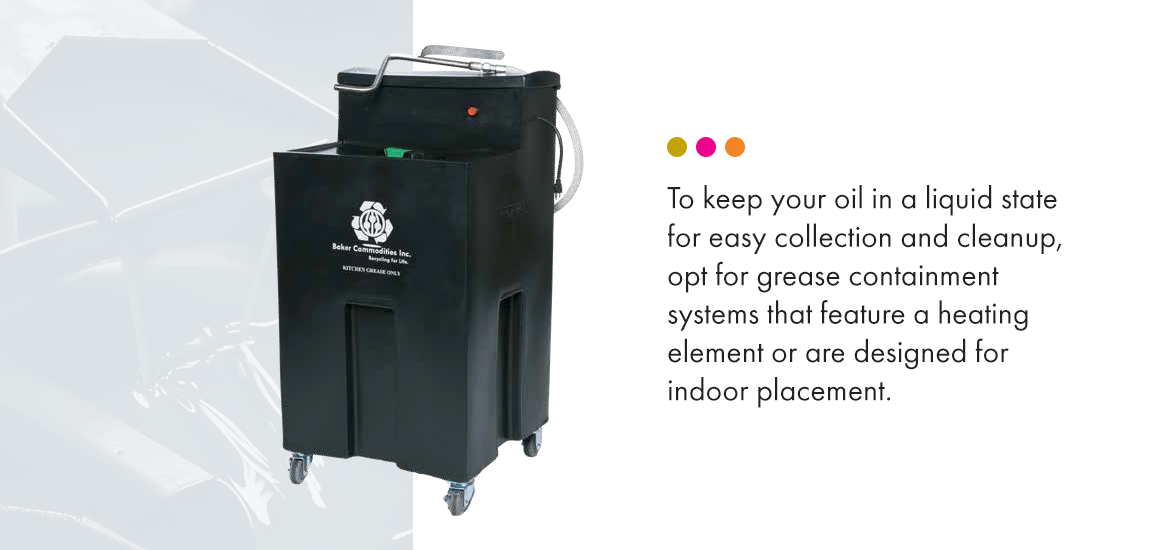Cold Weather Grease Collection
Cooking oil and grease are essential ingredients for great-tasting food. Whether it’s chicken grease from a roast or olive oil for a stir-fry, most dishes in the food services industry use some form of cooking oil. However, once you’ve used the oil and grease, you may be wondering what to do with all the excess.
If you operate in areas like New York or Massachusetts where snow, ice and freezing temperatures make their frigid presence felt for a portion of the year, you may have even more questions. The equation of freezing temperatures and cooking oil often equals a congealed mess that can be difficult to dispose of properly. Luckily, many solutions exist to help you keep oil and grease under control during the colder months.
Making sure you frequently dispose of your excess oil and grease in the winter and enlisting the services of an oil and grease collection company can help you avoid complications with your drainage system.
Does Cooking Oil Freeze?
As cooking oil can become problematic in the northeast region during wintertime, you may be asking, “does vegetable oil freeze?” Or, is there a form of non-freezing grease? While most cooking oils don’t freeze thoroughly as water does, oils do solidify when they hit their freezing point. The specific freezing point depends on the oil, but oils tend to have very low freezing points, meaning it takes very cold temperatures to get them to change from a liquid to a solid.
Cooking oil also freezes differently from liquids like water. Most of the time, when oil encounters freezing temperatures, it forms a thick, crystallized gel. Though oil solidifies into a gel rather than freezing into a hard block of ice, it can still cause issues while frozen.
Often, business owners store their used oil in outdoor bins until an oil and grease collection company can collect it. However, freezing cooking oil is likely to solidify and create issues for the collection company. In scenarios where the oil collection bins become big blocks of cold grease, the collection company can have a difficult time removing the oil.
The Cost of Pouring Oil Down the Drain
Knowing the issues that can arise from storing used oil outside in the cold might propel you to seek alternative disposal methods. Grease in liquid form may have no issues washing down your drain, so your sink may seem like an easy and effective way to get rid of it. However, while you may be tempted to let your used grease flow through your draining system — out of sight, out of mind — that solution trades short-term gain for long-term pain.
Pouring used cooking oil down the drain is illegal due to the environmental complications it creates and can result in fines. Grease dumping can create blocks in sewers, resulting in burst pipes, flooding and backwashing of waste into local environments.
Think back to what happens when oil encounters freezing temperatures. When you pour oil down the drain in the winter, it will eventually run through cold pipes, where it will thicken and solidify in place. Solid oil can cause blockages and backups that obstruct plumbing and require professional cleaning to get your drainage system back to normal.
Your business’s facilities most likely include some form of grease trap or interceptor, which is designed to filter out any fat, oil or grease before depositing water into the larger sewage system. These traps can be helpful for washing the occasional greasy plate, but you should avoid overloading them with copious amounts of oil at any time of year, as they’re only designed to trap small amounts of grease at a time.
A professional oil and grease collection company will clean the grease traps periodically. If you make a habit of pouring grease down the drains at your facility, you’ll need to get the traps cleaned more frequently, which creates unnecessary costs for your business. In addition, grease consistency matters for good grease trap cleaning. If the oil is in a liquid state, the collection company can pump it out of the grease system. However, pumping out solidified grease is not so simple and requires several steps to be effective, driving up costs.
Pouring oil down the drain results in a more expensive and labor-intensive situation for both your business and the grease collection company.

Grease Container Solutions for Low Temperatures
Instead of pouring oil down the drain, invest in a quality grease containment system that keeps the oil in a liquid state until it can be emptied.
With a variety of grease containers on the market, make sure you choose a functional solution to cold-temperature grease storage. To keep your oil in a liquid state for easy collection and cleanup, opt for grease containment systems that feature a heating element or are designed for indoor placement.
Indoor Containment Tanks
The most effective solution for combating cold weather in the northeast and ensuring your grease collection and disposal process occurs as smoothly as possible is to use indoor containment tanks. Note that indoor grease containers may cause some unique concerns, such as leakage and the need to find a convenient storage space inside your facility’s layout.
Therefore, if you opt for an indoor containment solution for grease collection, scope out an ideal location for the tank and measure the area. Account for the amount of storage space you’ll need to collect and dispose of your facility’s cooking oil efficiently.
Once you determine the indoor containment tank size you need, find one that fits the bill and is made with leak-proof material. Any leaks from the tank can create safety and hygiene problems in the workplace, so finding a leak-proof containment tank should be your primary consideration.
Outdoor Containment Tanks
A central issue with outdoor containment tanks is temperature regulation, particularly for areas with winters that frequently reach chilly temperatures like New York. The most effective way to combat oil solidification in freezing outdoor temperatures is with an outdoor containment system equipped with heating tubes to ensure the oil and grease remain in a liquid state regardless of the external temperature.
However, an additional concern with outdoor tanks is grease theft. While it may seem odd for someone to go through the trouble of illegally obtaining used oil and grease, these products hold value for generating renewable fuel and animal feed. People who illegally obtain oil and grease can sell them to biodiesel companies for cash.
To prevent grease theft, find an outdoor grease containment tank that comes equipped with a lock.
Specialized Trucks for Winter Grease Collection
If you need more unique options, you can consider other low-temperature grease collection solutions. Rather than keeping the grease in a perpetual liquid state, you can opt for a grease collection company to melt it for you.
A specialized truck, equipped with a motorized hoisting arm and a section filled with warm water, can hoist your grease collection tank and place it in the tub of warm water to melt the grease. Once the edges of the grease block melt, the truck will empty it into its collection area.
Whichever cold-weather solution you choose, you’ll be making a smart choice to avoid grease solidification and buildup.
Choose Baker Commodities for Convenient Cold Weather Grease Collection
At Baker Commodities, our grease collection and recycling programs make it easier for you to dispose of used cooking oil and grease in safe, legal and environmentally conscious ways, regardless of whether the weather outside is friendly or frightful!
We’re your one-stop shop for all your grease disposal, collection and recycling needs. From our indoor and outdoor containment tanks with locks to our specialized trucks for cold-weather grease collection, our professionals can take care of your grease in any weather.
If you’re looking for a convenient and environmentally responsible way to dispose of cooking oil and grease, we invite you to contact us today!




